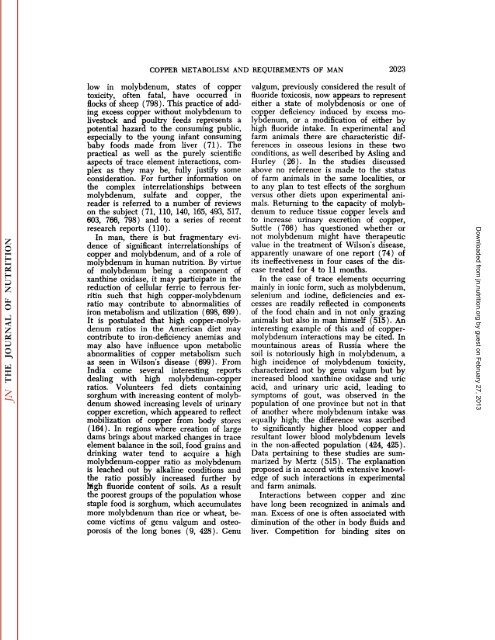conspectus of researchon copper metabolism and requirements
conspectus of researchon copper metabolism and requirements
conspectus of researchon copper metabolism and requirements
You also want an ePaper? Increase the reach of your titles
YUMPU automatically turns print PDFs into web optimized ePapers that Google loves.
COPPER METABOLISM AND REQUIREMENTS OF MAN 2023<br />
low in molybdenum, states <strong>of</strong> <strong>copper</strong><br />
toxicity, <strong>of</strong>ten fatal, have occurred in<br />
flocks <strong>of</strong> sheep (798). This practice <strong>of</strong> add<br />
ing excess <strong>copper</strong> without molybdenum to<br />
livestock <strong>and</strong> poultry feeds represents a<br />
potential hazard to the consuming public,<br />
especially to the young infant consuming<br />
baby foods made from liver (71). The<br />
practical as well as the purely scientific<br />
aspects <strong>of</strong> trace element interactions, com<br />
plex as they may be, fully justify some<br />
consideration. For further information on<br />
the complex interrelationships between<br />
molybdenum, sulfate <strong>and</strong> <strong>copper</strong>, the<br />
reader is referred to a number <strong>of</strong> reviews<br />
on the subject (71, 110, 140, 165, 493, 517,<br />
603, 766, 798) <strong>and</strong> to a series <strong>of</strong> recent<br />
research reports (110).<br />
In man, there is but fragmentary evi<br />
dence <strong>of</strong> significant interrelationships <strong>of</strong><br />
<strong>copper</strong> <strong>and</strong> molybdenum, <strong>and</strong> <strong>of</strong> a role <strong>of</strong><br />
molybdenum in human nutrition. By virtue<br />
<strong>of</strong> molybdenum being a component <strong>of</strong><br />
xanthine oxidase, it may participate in the<br />
reduction <strong>of</strong> cellular ferric to ferrous fer<br />
ritin such that high <strong>copper</strong>-molybdenum<br />
ratio may contribute to abnormalities <strong>of</strong><br />
iron <strong>metabolism</strong> <strong>and</strong> utilization (698, 699).<br />
It is postulated that high <strong>copper</strong>-molyb<br />
denum ratios in the American diet may<br />
contribute to iron-deficiency anemias <strong>and</strong><br />
may also have influence upon metabolic<br />
abnormalities <strong>of</strong> <strong>copper</strong> <strong>metabolism</strong> such<br />
as seen in Wilson's disease (699). From<br />
India come several interesting reports<br />
dealing with high molybdenum-<strong>copper</strong><br />
ratios. Volunteers fed diets containing<br />
sorghum with increasing content <strong>of</strong> molyb<br />
denum showed increasing levels <strong>of</strong> urinary<br />
<strong>copper</strong> excretion, which appeared to reflect<br />
mobilization <strong>of</strong> <strong>copper</strong> from body stores<br />
(164). In regions where creation <strong>of</strong> large<br />
dams brings about marked changes in trace<br />
element balance in the soil, food grains <strong>and</strong><br />
drinking water tend to acquire a high<br />
molybdenum-<strong>copper</strong> ratio as molybdenum<br />
is leached out by alkaline conditions <strong>and</strong><br />
the ratio possibly increased further by<br />
high fluoride content <strong>of</strong> soils. As a result<br />
the poorest groups <strong>of</strong> the population whose<br />
staple food is sorghum, which accumulates<br />
more molybdenum than rice or wheat, be<br />
come victims <strong>of</strong> genu valgum <strong>and</strong> osteo<br />
porosis <strong>of</strong> the long bones (9, 428). Genu<br />
valgum, previously considered the result <strong>of</strong><br />
fluoride toxicosis, now appears to represent<br />
either a state <strong>of</strong> molybdenosis or one <strong>of</strong><br />
<strong>copper</strong> deficiency induced by excess mo<br />
lybdenum, or a modification <strong>of</strong> either by<br />
high fluoride intake. In experimental <strong>and</strong><br />
farm animals there are characteristic dif<br />
ferences in osseous lesions in these two<br />
conditions, as well described by Asling <strong>and</strong><br />
Hurley (26). In the studies discussed<br />
above no reference is made to the status<br />
<strong>of</strong> farm animals in the same localities, or<br />
to any plan to test effects <strong>of</strong> the sorghum<br />
versus other diets upon experimental ani<br />
mals. Returning to the capacity <strong>of</strong> molyb<br />
denum to reduce tissue <strong>copper</strong> levels <strong>and</strong><br />
to increase urinary excretion <strong>of</strong> <strong>copper</strong>,<br />
Suttle (766) has questioned whether or<br />
not molybdenum might have therapeutic<br />
value in the treatment <strong>of</strong> Wilson's disease,<br />
apparently unaware <strong>of</strong> one report (74) <strong>of</strong><br />
its ineffectiveness in four cases <strong>of</strong> the dis<br />
ease treated for 4 to 11 months.<br />
In the case <strong>of</strong> trace elements occurring<br />
mainly in ionic form, such as molybdenum,<br />
selenium <strong>and</strong> iodine, deficiencies <strong>and</strong> ex<br />
cesses are readily reflected in components<br />
<strong>of</strong> the food chain <strong>and</strong> in not only grazing<br />
animals but also in man himself (515). An<br />
interesting example <strong>of</strong> this <strong>and</strong> <strong>of</strong> <strong>copper</strong>molybdenum<br />
interactions may be cited. In<br />
mountainous areas <strong>of</strong> Russia where the<br />
soil is notoriously high in molybdenum, a<br />
high incidence <strong>of</strong> molybdenum toxicity,<br />
characterized not by genu valgum but by<br />
increased blood xanthine oxidase <strong>and</strong> uric<br />
acid, <strong>and</strong> urinary uric acid, leading to<br />
symptoms <strong>of</strong> gout, was observed in the<br />
population <strong>of</strong> one province but not in that<br />
<strong>of</strong> another where molybdenum intake was<br />
equally high; the difference was ascribed<br />
to significantly higher blood <strong>copper</strong> <strong>and</strong><br />
resultant lower blood molybdenum levels<br />
in the non-affected population (424, 425).<br />
Data pertaining to these studies are sum<br />
marized by Mertz (515). The explanation<br />
proposed is in accord with extensive knowl<br />
edge <strong>of</strong> such interactions in experimental<br />
<strong>and</strong> farm animals.<br />
Interactions between <strong>copper</strong> <strong>and</strong> zinc<br />
have long been recognized in animals <strong>and</strong><br />
man. Excess <strong>of</strong> one is <strong>of</strong>ten associated with<br />
diminution <strong>of</strong> the other in body fluids <strong>and</strong><br />
liver. Competition for binding sites on<br />
Downloaded from<br />
jn.nutrition.org<br />
by guest on February 27, 2013
















